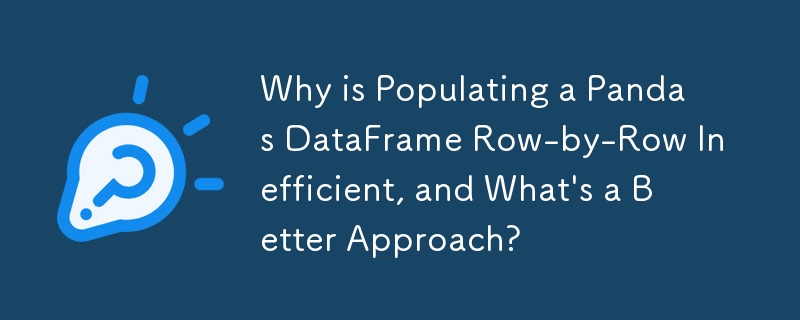

Creating and Populating an Empty Pandas DataFrame
Conceptually, one may want to start by creating an empty DataFrame and then incrementally fill it with values. However, this approach is inefficient and prone to causing performance issues.
The Pitfalls of Growing a DataFrame Row-wise
Iteratively appending rows to an empty DataFrame is computationally expensive. It leads to quadratic complexity operations due to the dynamic memory allocation and reassignment required. This can severely impact performance, especially when dealing with large datasets.
An Alternative Approach: Accumulating Data in a List
Instead of growing a DataFrame row-wise, it's recommended to accumulate data in a list. This has several advantages:
Creating a DataFrame from a List
Once data has been accumulated in a list, a DataFrame can be easily created by converting the list using pd.DataFrame(). This ensures proper data type inference and automates setting a RangeIndex for the DataFrame.
Example
Consider the scenario described in the question. The following code demonstrates how to accumulate data in a list and then create a DataFrame:
import pandas as pd
data = []
dates = [pd.to_datetime(f"2023-08-{day}") for day in range(10, 0, -1)]
valdict = {'A': [], 'B': [], 'C': []} # Initialize symbol value lists
for date in dates:
for symbol in valdict:
if date == dates[0]:
valdict[symbol].append(0)
else:
valdict[symbol].append(1 + valdict[symbol][-1])
# Create a DataFrame from the accumulated data
df = pd.DataFrame(valdict, index=dates)This approach ensures efficient data accumulation and seamless DataFrame creation without any performance overhead or concerns about object columns.
The above is the detailed content of Why is Populating a Pandas DataFrame Row-by-Row Inefficient, and What\'s a Better Approach?. For more information, please follow other related articles on the PHP Chinese website!
 How to restore videos that have been officially removed from Douyin
How to restore videos that have been officially removed from Douyin
 js method to generate random numbers
js method to generate random numbers
 How high will Ethereum go?
How high will Ethereum go?
 How to recover deleted files on computer
How to recover deleted files on computer
 How many years do you have to pay for medical insurance to enjoy lifelong medical insurance?
How many years do you have to pay for medical insurance to enjoy lifelong medical insurance?
 What to do if there is no cursor when clicking on the input box
What to do if there is no cursor when clicking on the input box
 What should I do if English letters appear when I turn on the computer and the computer cannot be turned on?
What should I do if English letters appear when I turn on the computer and the computer cannot be turned on?
 How to create virtual wifi in win7
How to create virtual wifi in win7




